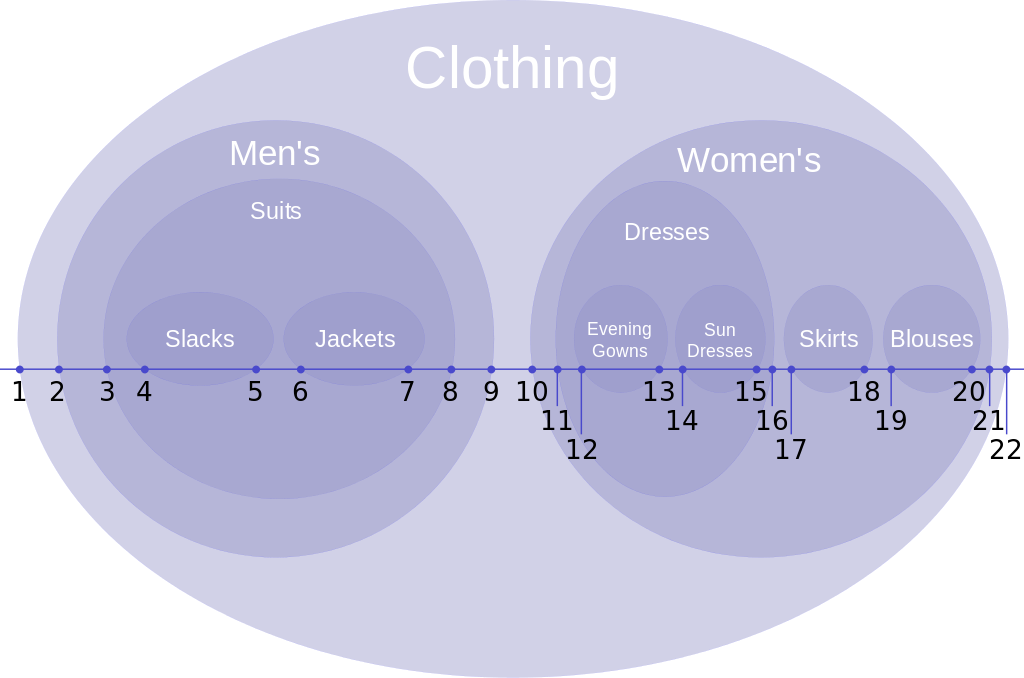laravel implements infinite classification
Explanation
Everyone usually uses recursion to implement infinite classification. We all know that recursion is very inefficient. Here is a Laravel expansion package recommended etrepat/baum, quickly make your data model support infinite tree hierarchical structure while taking into account efficiency.
Using the Baum nested set model to implement the infinite classification of the Laravel model
The official documentation of the expansion package has explanation space, and the picture below is also one Simple example:

Use case description
# Next, let’s talk about a few examples of infinite tree hierarchical models.
Tag system
#Reference: Laravel Taggable Adds tagging function to your model. A tag can have countless child tags, belong to one parent tag, and have multiple peer tags.
For example, the tag tree below:
$tagTree = [
'name' => 'RootTag',
'children' => [
['name' => 'L1Child1',
'children' => [
['name' => 'L2Child1'],
['name' => 'L2Child1'],
['name' => 'L2Child1'],
]
],
['name' => 'L1Child2'],
['name' => 'L1Child3'],
]];Comment system
#Infinitely nested comments, such as NetEase's comment system.

Laravel has a comment extension that supports unlimited nesting, see Slynova-Org/laravel-commentable.
「Navigation bar」data model
#The administrator backend needs to provide the customization function of "Navigation bar", a tree-structured navigation bar.

Integrate Baum
#etrepat/baum Quickly make your data model support the infinite tree hierarchical structure while taking into account efficiency.
Next let’s talk about how to integrate.
1. Composer installation
#composer require "baum/baum:~1.1"
2. Add provider
#Modify the config/app.php file in providers Add to the array:
'Baum\Providers\BaumServiceProvider',
This service provider has registered two commands: artisan baum, artisan baum.install.
3. Create migration
#Install it on the existing data model:
php artisan baum:install MODEL
Then execute
php artisan migrate
Field introduction about migration
#parent_id: the id of the parent node
lft: the left index value
rgt: the right index value
depth: Hierarchical depth
The following is an example:
class Category extends Migration {
public function up() {
Schema::create('categories', function(Blueprint $table) {
$table->increments('id');
// 这四行代码
$table->integer('parent_id')->nullable();
$table->integer('lft')->nullable();
$table->integer('rgt')->nullable();
$table->integer('depth')->nullable();
$table->string('name', 255);
$table->timestamps();
});
}}4. Configure the data model
#Inherit Baum\Node
class Category extends Baum\Node {}After inheritance, these properties can be overridden:
class Category extends Baum\Node {
protected $table = 'categories';
// 'parent_id' column name
protected $parentColumn = 'parent_id';
// 'lft' column name
protected $leftColumn = 'lidx';
// 'rgt' column name
protected $rightColumn = 'ridx';
// 'depth' column name
protected $depthColumn = 'nesting';
// guard attributes from mass-assignment
protected $guarded = array('id', 'parent_id', 'lidx', 'ridx', 'nesting');}The integration is successful.
Use
$root = Tag::create(['name' => 'Root']);
// 创建子标签
$child1 = $root->children()->create(['name' => 'Child1']);
$child = Tag::create(['name' => 'Child2']);
$child->makeChildOf($root);
// 批量构建树
$tagTree = [
'name' => 'RootTag',
'children' => [
['name' => 'L1Child1',
'children' => [
['name' => 'L2Child1'],
['name' => 'L2Child1'],
['name' => 'L2Child1'],
]
],
['name' => 'L1Child2'],
['name' => 'L1Child3'],
]
];
Tag::buildTree($tagTree);
Hot AI Tools

Undresser.AI Undress
AI-powered app for creating realistic nude photos

AI Clothes Remover
Online AI tool for removing clothes from photos.

Undress AI Tool
Undress images for free

Clothoff.io
AI clothes remover

Video Face Swap
Swap faces in any video effortlessly with our completely free AI face swap tool!

Hot Article

Hot Tools

Notepad++7.3.1
Easy-to-use and free code editor

SublimeText3 Chinese version
Chinese version, very easy to use

Zend Studio 13.0.1
Powerful PHP integrated development environment

Dreamweaver CS6
Visual web development tools

SublimeText3 Mac version
God-level code editing software (SublimeText3)

Hot Topics
 1664
1664
 14
14
 1423
1423
 52
52
 1317
1317
 25
25
 1268
1268
 29
29
 1246
1246
 24
24
 Laravel Introduction Example
Apr 18, 2025 pm 12:45 PM
Laravel Introduction Example
Apr 18, 2025 pm 12:45 PM
Laravel is a PHP framework for easy building of web applications. It provides a range of powerful features including: Installation: Install the Laravel CLI globally with Composer and create applications in the project directory. Routing: Define the relationship between the URL and the handler in routes/web.php. View: Create a view in resources/views to render the application's interface. Database Integration: Provides out-of-the-box integration with databases such as MySQL and uses migration to create and modify tables. Model and Controller: The model represents the database entity and the controller processes HTTP requests.
 Solve caching issues in Craft CMS: Using wiejeben/craft-laravel-mix plug-in
Apr 18, 2025 am 09:24 AM
Solve caching issues in Craft CMS: Using wiejeben/craft-laravel-mix plug-in
Apr 18, 2025 am 09:24 AM
When developing websites using CraftCMS, you often encounter resource file caching problems, especially when you frequently update CSS and JavaScript files, old versions of files may still be cached by the browser, causing users to not see the latest changes in time. This problem not only affects the user experience, but also increases the difficulty of development and debugging. Recently, I encountered similar troubles in my project, and after some exploration, I found the plugin wiejeben/craft-laravel-mix, which perfectly solved my caching problem.
 How to learn Laravel How to learn Laravel for free
Apr 18, 2025 pm 12:51 PM
How to learn Laravel How to learn Laravel for free
Apr 18, 2025 pm 12:51 PM
Want to learn the Laravel framework, but suffer from no resources or economic pressure? This article provides you with free learning of Laravel, teaching you how to use resources such as online platforms, documents and community forums to lay a solid foundation for your PHP development journey from getting started to master.
 Laravel user login function
Apr 18, 2025 pm 12:48 PM
Laravel user login function
Apr 18, 2025 pm 12:48 PM
Laravel provides a comprehensive Auth framework for implementing user login functions, including: Defining user models (Eloquent model), creating login forms (Blade template engine), writing login controllers (inheriting Auth\LoginController), verifying login requests (Auth::attempt) Redirecting after login is successful (redirect) considering security factors: hash passwords, anti-CSRF protection, rate limiting and security headers. In addition, the Auth framework also provides functions such as resetting passwords, registering and verifying emails. For details, please refer to the Laravel documentation: https://laravel.com/doc
 Laravel framework installation method
Apr 18, 2025 pm 12:54 PM
Laravel framework installation method
Apr 18, 2025 pm 12:54 PM
Article summary: This article provides detailed step-by-step instructions to guide readers on how to easily install the Laravel framework. Laravel is a powerful PHP framework that speeds up the development process of web applications. This tutorial covers the installation process from system requirements to configuring databases and setting up routing. By following these steps, readers can quickly and efficiently lay a solid foundation for their Laravel project.
 What versions of laravel are there? How to choose the version of laravel for beginners
Apr 18, 2025 pm 01:03 PM
What versions of laravel are there? How to choose the version of laravel for beginners
Apr 18, 2025 pm 01:03 PM
In the Laravel framework version selection guide for beginners, this article dives into the version differences of Laravel, designed to assist beginners in making informed choices among many versions. We will focus on the key features of each release, compare their pros and cons, and provide useful advice to help beginners choose the most suitable version of Laravel based on their skill level and project requirements. For beginners, choosing a suitable version of Laravel is crucial because it can significantly impact their learning curve and overall development experience.
 How to view the version number of laravel? How to view the version number of laravel
Apr 18, 2025 pm 01:00 PM
How to view the version number of laravel? How to view the version number of laravel
Apr 18, 2025 pm 01:00 PM
The Laravel framework has built-in methods to easily view its version number to meet the different needs of developers. This article will explore these methods, including using the Composer command line tool, accessing .env files, or obtaining version information through PHP code. These methods are essential for maintaining and managing versioning of Laravel applications.
 The difference between laravel and thinkphp
Apr 18, 2025 pm 01:09 PM
The difference between laravel and thinkphp
Apr 18, 2025 pm 01:09 PM
Laravel and ThinkPHP are both popular PHP frameworks and have their own advantages and disadvantages in development. This article will compare the two in depth, highlighting their architecture, features, and performance differences to help developers make informed choices based on their specific project needs.




